原因状从,目的状从,结果状从
- 格式:doc
- 大小:29.00 KB
- 文档页数:3
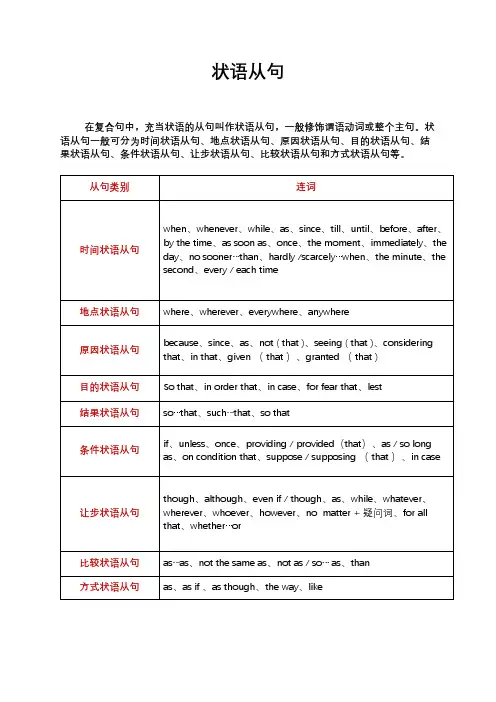
状语从句在复合句中,充当状语的从句叫作状语从句,一般修饰谓语动词或整个主句。
状语从句一般可分为时间状语从句、地点状语从句、原因状语从句、目的状语从句、结果状语从句、条件状语从句、让步状语从句、比较状语从句和方式状语从句等。
一、时间状语从句在复合句中起时间状语作用的从句称为时间状语从句,可放在句首、句中或句尾。
(二)until 和 till的用法1.肯定句:主句的谓语动词必须是延续性动词,主句、从句都为肯定式,意为“直到……为止”;2.否定句:主句的谓语动词必须是非延续性动词,从句为肯定式,表示“某动作直到某时才开始”;3.till 不可以置于句首,而until可以。
例:They waited till / until I returned.他们一直在等我回来。
You may stay here until / till the rain stops.你可以待在这里直到雨停。
He won’t go to bed until / till she returns.直到她回来,他才上床睡觉。
Until you told me I had no idea of it.直到你告诉我,我才知道这件事。
(三)since的用法(四)before的用法一般情况下before表示“在……之前”,有时根据上下文,还可表示“还未……就……” “不到……就……” “……才……” “趁……还未……”等例:Please write it down before you forget it.趁你还没忘,请把它记下来。
I must finish this letter before I go home.我必须在回家之前完成这封信。
Before I could get in a word, he had measured me.我还没来得及插话,他就给我量好了尺寸。
We had sailed four days and four nights before we saw land.我们航行了四天四夜才看到陆地。
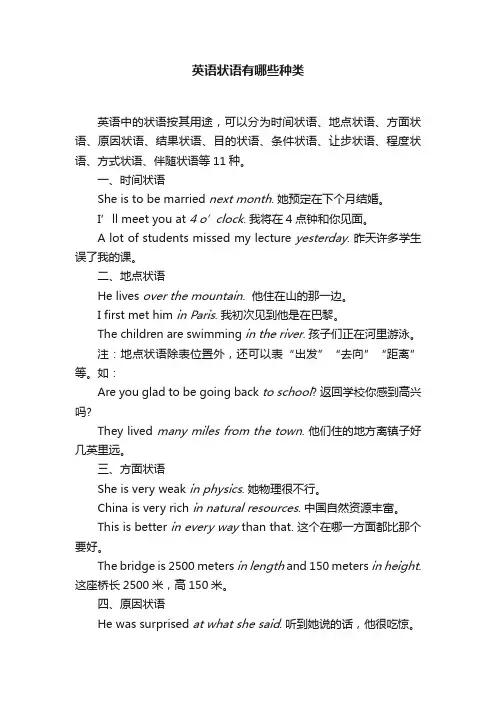
英语状语有哪些种类英语中的状语按其用途,可以分为时间状语、地点状语、方面状语、原因状语、结果状语、目的状语、条件状语、让步状语、程度状语、方式状语、伴随状语等11种。
一、时间状语She is to be married next month. 她预定在下个月结婚。
I’ll meet you at 4 o’clock. 我将在4点钟和你见面。
A lot of students missed my lecture yesterday. 昨天许多学生误了我的课。
二、地点状语He lives over the mountain. 他住在山的那一边。
I first met him in Paris. 我初次见到他是在巴黎。
The children are swimming in the river. 孩子们正在河里游泳。
注:地点状语除表位置外,还可以表“出发”“去向”“距离”等。
如:Are you glad to be going back to school? 返回学校你感到高兴吗?They lived many miles from the town. 他们住的地方离镇子好几英里远。
三、方面状语She is very weak in physics. 她物理很不行。
China is very rich in natural resources. 中国自然资源丰富。
This is better in every way than that. 这个在哪一方面都比那个要好。
The bridge is 2500 meters in length and 150 meters in height. 这座桥长2500米,高150米。
四、原因状语He was surprised at what she said. 听到她说的话,他很吃惊。
He succeeded by hard work. 他由于努力工作而成功。
He was sent to prison for robbery. 他因为抢劫而坐牢。
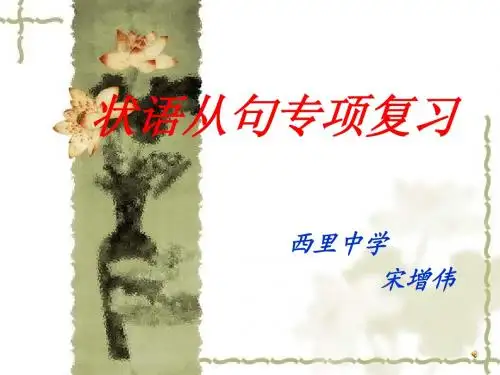

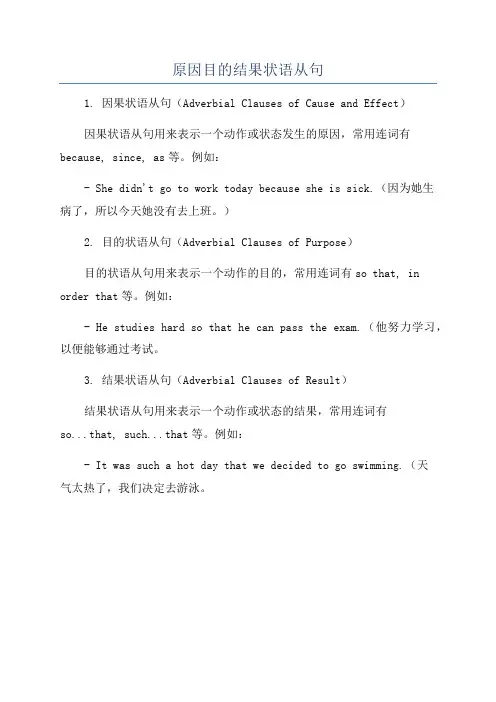
原因目的结果状语从句
1. 因果状语从句(Adverbial Clauses of Cause and Effect)
因果状语从句用来表示一个动作或状态发生的原因,常用连词有because, since, as等。
例如:
- She didn't go to work today because she is sick.(因为她生
病了,所以今天她没有去上班。
)
2. 目的状语从句(Adverbial Clauses of Purpose)
目的状语从句用来表示一个动作的目的,常用连词有so that, in order that等。
例如:
- He studies hard so that he can pass the exam.(他努力学习,以便能够通过考试。
3. 结果状语从句(Adverbial Clauses of Result)
结果状语从句用来表示一个动作或状态的结果,常用连词有
so...that, such...that等。
例如:
- It was such a hot day that we decided to go swimming.(天
气太热了,我们决定去游泳。
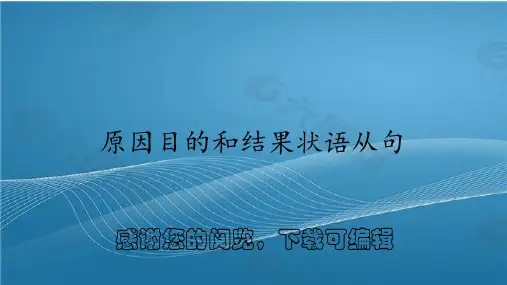
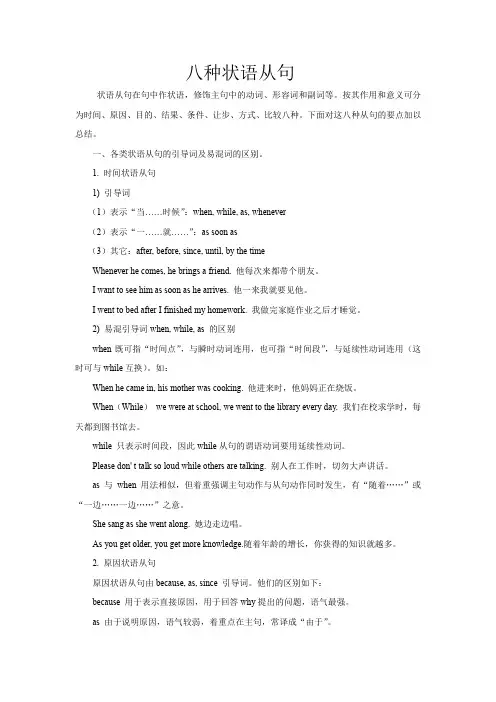
八种状语从句状语从句在句中作状语,修饰主句中的动词、形容词和副词等。
按其作用和意义可分为时间、原因、目的、结果、条件、让步、方式、比较八种。
下面对这八种从句的要点加以总结。
一、各类状语从句的引导词及易混词的区别。
1. 时间状语从句1) 引导词(1)表示“当……时候”:when, while, as, whenever(2)表示“一……就……”:as soon as(3)其它:after, before, since, until, by the timeWhenever he comes, he brings a friend. 他每次来都带个朋友。
I want to see him as soon as he arrives. 他一来我就要见他。
I went to bed after I finished my homework. 我做完家庭作业之后才睡觉。
2) 易混引导词when, while, as 的区别when既可指“时间点”,与瞬时动词连用,也可指“时间段”,与延续性动词连用(这时可与while互换)。
如:When he came in, his mother was cooking. 他进来时,他妈妈正在烧饭。
When(While)we were at school, we went to the library every day. 我们在校求学时,每天都到图书馆去。
while 只表示时间段,因此while从句的谓语动词要用延续性动词。
Please don' t talk so loud while others are talking. 别人在工作时,切勿大声讲话。
as 与when 用法相似,但着重强调主句动作与从句动作同时发生,有“随着……”或“一边……一边……”之意。
She sang as she went along. 她边走边唱。
As you get older, you get more knowledge.随着年龄的增长,你获得的知识就越多。
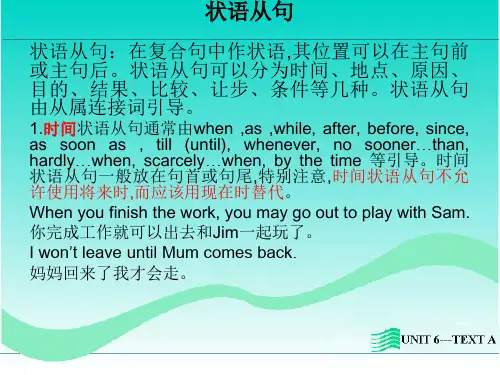
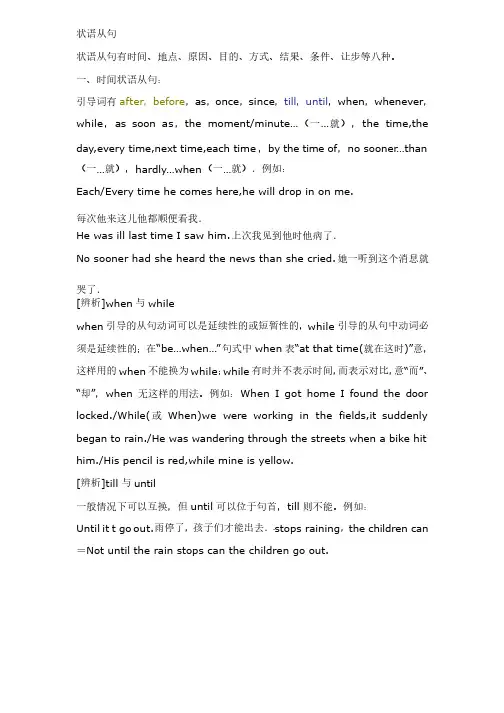
状语从句状语从句状语从句有时间、地点、原因、目的、方式、结果、条件、让步等八种。
状语从句有时间、地点、原因、目的、方式、结果、条件、让步等八种。
一、时间状语从句:一、时间状语从句:引导词有after ,before ,as ,once ,since ,till ,until ,when ,whenever ,while ,as soon as ,the moment/minute…(一…就),the time,theday,every time,next time,each time ,by the time of ,no sooner …than(一…就),hardly…when (一…就).例如:就).例如:Each/Every time he comes here,he will drop in on me.每次他来这儿他都顺便看我.每次他来这儿他都顺便看我.He was ill last time I saw him.上次我见到他时他病了.上次我见到他时他病了.No sooner had she heard the news than she cried.她一听到这个消息就哭了.哭了.[辨析]when 与whilewhen 引导的从句动词可以是延续性的或短暂性的,while 引导的从句中动词必须是延续性的;须是延续性的;在在“be…when…”句式中when 表“at that time “at that time((就在这时)”意,这样用的when 不能换为while ;while 有时并不表示时间,而表示对比,意“而”、“却”,when 无这样的用法。
例如:When I got home I found the doorlocked./While(或When)we were working in the fields,it suddenlybegan to rain./He was wandering through the streets when a bike hithim./His pencil is red,while mine is yellow.[辨析]till 与until一般情况下可以互换,但until 可以位于句首,till 则不能。
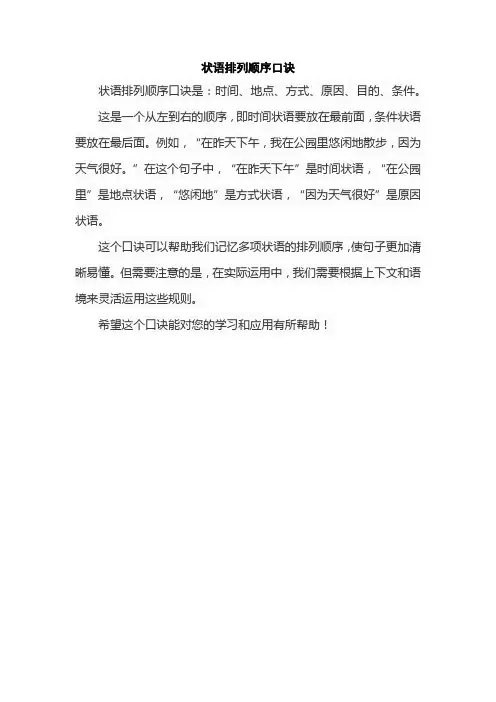
状语排列顺序口诀
状语排列顺序口诀是:时间、地点、方式、原因、目的、条件。
这是一个从左到右的顺序,即时间状语要放在最前面,条件状语要放在最后面。
例如,“在昨天下午,我在公园里悠闲地散步,因为天气很好。
”在这个句子中,“在昨天下午”是时间状语,“在公园里”是地点状语,“悠闲地”是方式状语,“因为天气很好”是原因状语。
这个口诀可以帮助我们记忆多项状语的排列顺序,使句子更加清晰易懂。
但需要注意的是,在实际运用中,我们需要根据上下文和语境来灵活运用这些规则。
希望这个口诀能对您的学习和应用有所帮助!。

状语从句在复合句中作状语的从句叫状语从句。
状语从句有时间、地点、原因、目的、结果、条件、方式、比较、让步等种类。
一、时间状语从句引导时间状语从句的连接词有: when, as, while, after, before, since, ever since, as soon as, once, till, until, whenever, no sooner…than, hardly/scarcely...when, themoment/minute/instant/second, every time, each time, any time, the first time, next time, last time, all the time, by the time, directly, immediately, instantly等。
1.表示“一···就···”的句型1) as soon as/onceAs soon as he arrives, I'll call you.他一到,我就给你打电话。
(as soon as 侧重时间或动作先后衔接紧,而once侧重条件,表示“一旦...”)2) on doing sth/on one's + n.作时间状语On arriving at the station, the thief was arrested.一到达车站,这个小偷就被逮捕了。
On his arrival in Paris, he was recognized as a noble and thrown into prison. 他一到达巴黎,就被认出是一个贵族,并被投入监狱。
3) no sooner ...than , hardly/scarcely...when它们表“一…就”。
结构中的否定词放在句首时,主句要倒装。
状语从句和后置定语状语从句是由连词或者关联词引导的修饰整个句子或者句子的某个成分的从句。
后置定语是修饰名词的修饰语,放在被修饰名词的后面。
下面我将分别详细介绍状语从句和后置定语。
一、状语从句:状语从句常可分为时间、地点、原因、方式、条件、目的等几种类型。
下面我将分别从这几个方面来详细解释。
1. 时间状语从句:时间状语从句是用来表示动作发生的时间的从句,通常由时间连词引导,如when、while、before、after等。
例如:- I will call you when I arrive home.(当我到家时,我会给你打电话。
)- He was studying English while his sister was playing the piano.(当他妹妹在弹钢琴的时候,他在学英语。
)2. 地点状语从句:地点状语从句是用来表示动作发生的地点的从句,通常由地点连词引导,如where、wherever等。
例如:- He always goes to the library where he can find quiet to study.(他经常去图书馆,那里他可以找到安静的环境来学习。
)- You can sit wherever you like.(你可以坐在你喜欢的任何地方。
)3. 原因状语从句:原因状语从句是用来表示动作发生的原因的从句,通常由原因连词引导,如because、since、as等。
例如:- I couldn't go to the party because I was busy.(因为我忙,所以无法去参加聚会。
)- She didn't pass the exam since she didn't study hard.(因为她没用努力学习,所以没能通过考试。
)4. 方式状语从句:方式状语从句是用来表示动作进行的方式的从句,通常由方式连词引导,如as、as if等。
英语目的状语从句结果状语从句目的状语从句是在句子中表示目的、意图或目标的从句,通常由 "in order that", "so that", "lest", "for fear that" 等引导。
例如:I study hard every day in order that I can get good grades.(我每天努力学习,以便取得好成绩。
)He gets up early every morning so that he can catch the bus.(他每天早上早起,以便能赶上公交车。
)We spoke in a low voice lest we should wake the baby.(我们低声说话,以免吵醒婴儿。
)结果状语从句是在句子中表示结果的从句,通常由"so that", "such that", "so...that...", "such...that..." 等引导。
例如:He is so talented that he can play multiple musical instruments.(他如此有天赋,以至于他可以演奏多种乐器。
)She is such a good singer that everyone loves her songs.(她是一位如此出色的歌手,以至于每个人都喜欢她的歌曲。
)The weather was so cold that we couldn't go outside.(天气太冷了,以至于我们不能出去。
)It was such a beautiful day that we decided to go for a picnic.(天气如此美好,以至于我们决定去野餐。
英语八类状语从句的用法归纳一、概说状语从句即指在主从复合句用作状语的从句。
按照其意义,状语从句可分为时间状语从句、地点状语从句、原因状语从句、目的状语从句、结果状语从句、条件状语从句、让步状语从句等。
状语从句是高中英语学习中的一个语法重点,也是历年高考重点考查的内容之一。
学习状语从句主要应注意引导状语从句的从属连词的用法与区别,以及从属连词在一定的语言环境中的意义与用法。
二、时间状语从句1.引导时间状语从句的从属连词很多,常见的有before, after, when, while, as, since, till, until, as soon as 等。
2.表示“当…时候”的 while, when, as 的用法区别是:while从句中的谓语动词必须是延续性动词;表示带有规律性的“每当”或当主、从句谓语动词的动作发生有先后时,只能用 when;当表示“一边…一边…”或“随着”时,只能用 as。
另外,用于此义的 as 所引导的时间状语从句谓语只能是动作动词,不能是状态动词。
如下面一道高考题的答案是 B 而不能是A:“I’m going to the post office.” “_____ you’re there, can you get me some stamps?”A. AsB. WhileC. BecauseD. If3. until 在肯定句中通常只连用延续性动词,表示相应动作结束的时间;在否定句中通常连用非延续性动词,表示相应动作开始的时间,意为“直到…才”。
如:He waited until she was about to leave. 他等着一直到她准备离开。
I did not begin to work till he had gone. 他走了后我才开始工作。
4.表示“一…就”除用 as soon as 外,还可用 the minute, the second, the instant, immediately, directly, instantly, no sooner…than, hardly…when等。
I状语从句类型。
逻辑关系1.Morissette said to the large crowded before she started to play.________2.While I watched and listened, I knew that I was seeing the performance of areal super star. ________3.You are free to go wherever you like. ________4.As his mother was a great music lover, he lived with music from birth. ________5.She had to draw piano keys on a piece of paper so that he could learn to playas early as possible.________ 6.Although the concert hall was cold and the sound system caused a fewproblems, the audience could still enjoy the concert. _______ 7.He was made to practise the piano so much that, at times, he thought aboutgiving up.________8.Henry doesn’t have so/as many books as I have. _______9.If I don’t finish my project on the history of the Internet for next Monday’slesson, the science teacher will be angry. _______ 10.Kong did as his mother told him to do and finially succeeded. _______ II.状语从句详解(一)原因状从原因状语从句连接词:as, because, since, now (that) (既然), for (由于),considering that(顾及到), seeing that(由于):Seeing (that) quite a few people were absent, we decided to put the meeting off.Considering that they are just beginners, they are doing quite a good job.________________________________, let’s try and reach a decision.(既然你们都在这儿)___________________________________________________. 由于她病了,她没有参加聚会。
★比较because, since, as和for:I didn't go, _________ I was afraid.____________ the weather is so bad, we have to delay our journey.He is absent today, _____________ he is ill.He must be ill, ______________ he is absent today.It’s morning now, _______________ the birds are singing.(二)目的状语从句that, so that, in order that, for fear that, in caseYou must speak louder .(以便大家能听到)He wrote the name down __________________________________.(以防他忘了)Better take more clothes_____________________________.(以防天气冷)(三)结果状语从句so… that 或such…that;so 还可与表示数量的形容词many, few, much, little连用,形成固定搭配。
___________________________________________________.(这个孩子太小,他不能上学) ________________________________________________.他赚如此少的钱以致于不能养家。
So clever___________________________________________________________他如此聪明以致于他能解决所有的难题.(四)让步状语从句:though, although, as; even if, even though; whether...or...; no matter+wh-,wh-ever。
(1)though, although可与yet, still或never,the less连用,但不能与but连用。
_____________________________, (still) he kept on working.(尽管他筋疲力尽)__________________________________, (yet) he is quite strong.(尽管他很老了)(2)as, though表示“虽然……但是”,“纵使……”之意。
_______________________, I’ll go.(纵使你反对)_____________________________, he makes little progress. (虽然他很努力)______________________________, he knew what was the right thing to do.(虽然他只是个孩子) (3)even if, even though 表示“即使……”,“纵使……”We’ll make a trip _______________________________.(即使天气不好)_______________________________________________.即使他很穷,她也深爱着他.(4)whether...or...表示“不论是否……”,“不管是……还是……”____________________________________________.无论你是忙还是闲,你都将参加这个仪式. ________________________, it's true. (不管你信还是不信)(5)“no matter+疑问词”或“疑问词-ever”的含义为“……都……;不管……都……”______________________________________________________.无论发生什么事,他都不介意. ____________________________________________________.无论你是谁,你都必须遵守法律。
★“疑问词-evr”还可以引导名词性从句:______________________________________________. 你给我什么,我就会吃什么。
__ .论谁来都受欢迎。
★ while引导让步状语从句,但一般要位于句首:_____________________ , I don't like the shape.(尽管我喜欢这颜色)翻译练习Group 1:原因状语1.由于在下雨,我们不去公园了。
2.既然大家都在,我们开始开会吧。
3.他不了解此事,因为他没有看过这部电影.4.我们得快点儿,天快黑了。
.5.既然你得到了一个机会,你就要好好利用它。
Group 2: 目的状语1.我慢慢说以便你能听懂。
.2.为了能看到日出,我们很早就出发去了山顶。
3.那个男孩藏在树后面,以防他父亲看到他。
Group 3: 结果状语1.迈克是一个如此诚实的人以至于大家都很信任他。
.2.爱因斯坦是如此聪明的一个学生以至于他能算出所有的难题..Group 4: 让步状语1.他不快乐,尽管他有很多钱。
2.尽管雨下得很大,他们仍然继续踢球。
.3.尽管她是孩子,她却懂得很多。
.仅供个人用于学习、研究;不得用于商业用途。
For personal use only in study and research; not for commercial use.Nur für den persönlichen für Studien, Forschung, zu kommer ziellen Zwecken verwendet werden.Pour l 'étude et la recherche uniquement à des fins personnelles; pas à des fins commerciales.толькодля людей, которые используются для обучения, исследований и не должны использоваться в коммерческих целях.以下无正文。